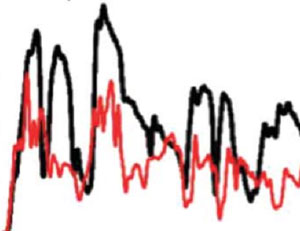
Projects in the Speech Perception Laboratory focus on understanding speech under adverse listening conditions. Specific focus is given to identifying the acoustic and linguistic properties of speech that are the most informative under different listening conditions. We are particularly interested in how aging and hearing impairment modifies the perceptual use of these informative speech properties. The goal of all of our projects is to identify the most important cues for listeners to use in different listening conditions in order to improve the programming of assistive listening devices and design of training protocols.
Projects in Auditory Cognitive Science
The Speech Perception Laboratory studies speech understanding difficulties under adverse listening conditions with specific clinical applications. Current projects include:

Identification of speech from partial information:
Everyday listening environments are complex. This project investigates how listeners process speech when only partial information is available due to competing or interrupting noise sources, such as a competing talker.

Spectro-temporal analysis of speech and noise:
This project examines the acoustic and perceptual interaction of speech and noise in order to predict speech understanding. Particular focus is given to the temporal and spectro-temporal modulation properties of speech and noise.

Multidimensional assessment of speech understanding:
Experimental and clinical tasks of speech understanding commonly assess the ability to identify or repeat words and sentences. This project examines the acoustic and linguistic factors that explain when and why individuals make errors during recognition.

Individual auditory and cognitive abilities of older adults:
This work investigates the individual abilities that predict speech understanding in complex environments. A specific focus is given to older adults with hearing loss in order to improve the prescription fitting of hearing aids and other hearing devices.
Public Health Relevance
The research activities detailed above are applied to one of the leading public health concerns: hearing loss. Over 36 million American adults report some degree of hearing loss, yet less than 20 percent of adults who have hearing loss use hearing aids. Major technologic advances in hearing aids have improved speech recognition in quiet listening environments, but hearing-aid benefit is still limited in the presence of noise, especially backgrounds of competing speech. It is essential that the individual and environmental factors that limit speech understanding are identified in order to maximize the benefit older adults with hearing loss may receive from amplified speech in adverse listening conditions. With the increasing availability of personal hearing technologies, enhanced or augmented hearing for all listeners may be possible in challenging environments.
The laboratory builds upon established literature in computational models of automatic speech recognition and merges it with physiologically plausible models of neural synchronization and temporal processing. This innovative integration advances the study and prediction of how individual listeners process speech in realistic, temporally complex everyday environments. In this way, audiological treatment may be custom fit to the user, representing a significant step forward for precision audiology.